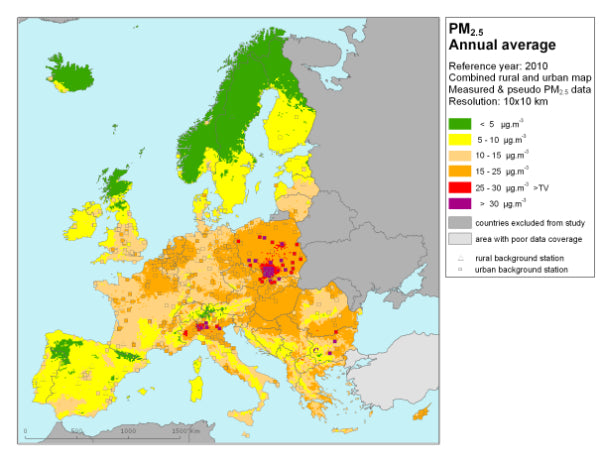A new scientific analysis of air pollution data and recorded deaths reveals that exposure to particulate pollution is linked to natural-cause mortality in a number of European countries, including the United Kingdom, The Netherlands and Switzerland. The new report is part of the European Study of Cohorts for Air Pollution Effects (ESCAPE), which is the first multi-centre study of the long-term exposure to air pollution and mortality covering a large study population in different European settings. Most significantly, it shows that exposure to fine particles (PM2.5) has an impact on mortality even below the limit of 25μg/m3 for PM2.5 set by European environmental legislation.
Till now, most research on the link between long-term exposure to particulate pollution on mortality has come from the United States. Studies have focused upon the effect of particulate matter (PM) of two kinds – PM10, consisting of particles of 10μm or less in size and PM2.5 which consists of smaller particles of size 2.5μm or less. These two types of PM are sometimes also known as coarse and fine particles respectively. Routine PM monitoring data from Europe has only recently become available (and was used in this new study). Previous work has, however, shown a link between mortality and exposure to nitrogen oxides (gaseous, not particulate) pollution in Europe.
In this study, the researchers looked at 22 population groups from 13 European countries enrolled in ongoing studies of pollution and health. Data from 367,251 participants was collected, accounting for over 5 million years of exposure (given that follow up was around 14 years). Air pollution monitoring data gave levels of coarse and fine PM and nitrogen oxides exposure. Traffic intensity (number of vehicles per day) and total traffic load were also recorded. Mortality statistics for the participants was drawn from death registries. The current study relates to all natural-cause mortality where pollution may play a role. Future analyses will report on how pollution affects the risk of specific causes of death – namely, lung cancer, stroke and heart disease.
The analysis showed raised increased risk of mortality for exposures to all air pollutants with a significantly raised risk for exposure to fine particles (PM2.5). The two measures of traffic exposure were also linked to increased mortality, though not significantly so. This risk remained at exposure levels below 25μg/m3 and 20μg/m3. It was only when levels of PM2.5 dropped below 15μg/m3 that this increased risk failed to reach significance. What is especially concerning here is that the European Commission air quality standards lay down an annual mean upper limit for PM2.5 pollution of 25μg/m3. On this new evidence it is beginning to look as if this level ought to be lowered.
The researchers note that their study goes beyond previous research on the effects of long-term exposure to PM2.5 pollution in that it has a very large number of participants, broad European coverage and also accounts for any confounding factors (by the nature of the analysis), thereby establishing a clear link between exposure and mortality. While this study focuses on PM2.5 as far as significance goes, the impact of PM10s should not be ignored. For, as tailpipe (exhaust) emissions are being reduced by environmental legislation non-tailpipe emissions, such as tyre or brake wear, are becoming more significant and these are a source of coarse particles.
More research must be done on the health impact of fine particles. Current biological pathways implicating them in health effects include setting up of chronic inflammation and triggering oxidative stress in the tissues. A recent study has also shown a link between black carbon (a source of fine particles) and telomere length. The telomeres are the ‘tips’ of their chromosomes and they tend to get shorter as we age. Thus, telomere length is taken as a sign of biological ageing. But we don’t need the exact mechanism by which fine particles damage the body to put in place urgent measures to reduce exposure, in light of these new findings.
Source: Beelen R, Raaschou-Nielsen O, Staffogia M et al (2013). Effects of long-term exposure to air pollution on natural-cause mortality: an analysis of 22 European cohorts within the multicentre ESCAPE project. The Lancet Early Online Publication 9 December (doi: 10.1016/S0140-6736(13)62158-3




